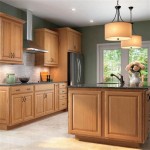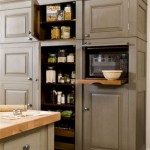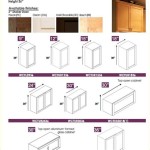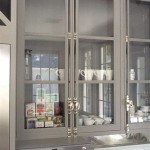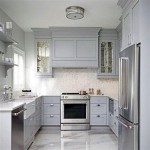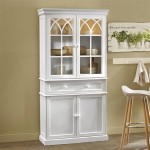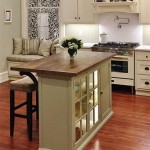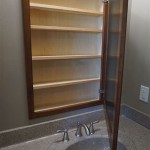How To Remove Grease And Grime From Kitchen Cabinets
Kitchen cabinets, particularly those near the stovetop, are magnets for grease, grime, and splattered food. Over time, this accumulation can create a sticky, unsightly layer that is difficult to remove. Regular cleaning is essential to maintain the appearance and hygiene of the kitchen. Understanding the correct methods and cleaning agents can significantly ease the process and prevent damage to the cabinet surfaces.
The frequency of cleaning depends on cooking habits and the proximity of the cabinets to cooking surfaces. Cabinets directly next to the stove might require weekly cleaning, while those further away can be cleaned less frequently, perhaps monthly. Ignoring the buildup of grease and grime can lead to a stubborn, hardened layer that necessitates more aggressive cleaning methods and runs the risk of damaging the cabinet finish.
Before commencing any cleaning process, it is crucial to identify the type of cabinet material. Most kitchen cabinets are made from wood, laminate, or painted surfaces, each requiring a different approach. Using the wrong cleaning agent or technique can result in discoloration, scratching, or even warping of the cabinet doors and frames.
Preparation is Key: Gathering Supplies and Protecting Surfaces
Prior to beginning the cleaning process, gather the necessary supplies. These will likely include:
*Microfiber cloths: These are gentle on surfaces and effective at lifting dirt and grease.
*Soft sponges: Avoid abrasive sponges, as they can scratch the cabinet finish.
*Warm water: The foundation of most cleaning solutions.
*Mild dish soap: A degreasing agent that is safe for most cabinet surfaces.
*Baking soda: A gentle abrasive for stubborn grime.
*White vinegar: A natural degreaser and disinfectant.
*Spray bottles: For dispensing cleaning solutions.
*Protective eyewear: To shield eyes from splashes.
*Gloves: To protect hands from cleaning agents and grime.
*Drop cloths or old towels: To protect countertops and floors from drips.
Protecting surrounding surfaces is equally important. Lay drop cloths or old towels on countertops and floors beneath the cabinets to catch any drips or spills. This prevents damage to these surfaces and simplifies the cleanup process.
Prior to applying any cleaning solution to the entire surface, test it in an inconspicuous area, such as the inside of a cabinet door or a corner. Observe the area for any adverse reactions, such as discoloration, streaking, or damage to the finish. This ensures that the chosen cleaning method is safe for the specific type of cabinet material.
Gentle Cleaning Solutions for Everyday Grease and Grime
For routine cleaning and removing light grease and grime, a simple solution of warm water and mild dish soap is often sufficient. This solution is gentle and safe for most cabinet surfaces, including wood, laminate, and painted finishes.
To prepare the solution, mix a few drops of dish soap into a bowl of warm water. Dip a microfiber cloth into the solution, wring out the excess water, and gently wipe down the cabinet surfaces. Pay particular attention to areas around handles, knobs, and near the stovetop, where grease and grime tend to accumulate.
After wiping the cabinets with the soapy solution, rinse them with a clean, damp microfiber cloth to remove any soap residue. Failure to rinse thoroughly can leave a sticky film that attracts more dirt and grease. Finally, dry the cabinets with a clean, dry microfiber cloth to prevent water spots and streaks.
An alternative gentle cleaning solution involves the use of white vinegar. Vinegar is a natural degreaser and disinfectant, making it effective for removing grease and grime. However, vinegar is acidic and should be diluted before use, especially on painted surfaces.
To prepare the vinegar solution, mix equal parts white vinegar and warm water in a spray bottle. Spray the solution onto the cabinet surfaces and let it sit for a few minutes to loosen the grease and grime. Wipe the cabinets with a clean, damp microfiber cloth, rinse with a clean, damp cloth, and dry with a clean, dry cloth.
Tackling Stubborn Grease and Grime: Advanced Cleaning Techniques
When dealing with stubborn grease and grime that has accumulated over time, more aggressive cleaning methods may be necessary. Baking soda is a gentle abrasive that can help to remove hardened grease without damaging the cabinet finish.
To use baking soda as a cleaning agent, create a paste by mixing baking soda with a small amount of water until it forms a thick consistency. Apply the paste to the affected areas and gently scrub with a soft sponge or microfiber cloth. Avoid using excessive pressure, as this can scratch the cabinet finish.
After scrubbing the cabinets with the baking soda paste, rinse them thoroughly with a clean, damp microfiber cloth to remove all traces of the baking soda residue. Dry the cabinets with a clean, dry microfiber cloth to prevent water spots and streaks.
Another effective method for removing stubborn grease involves using a specialized degreasing cleaner. These cleaners are formulated to dissolve grease and grime quickly and effectively. However, it is crucial to choose a degreasing cleaner that is safe for the specific type of cabinet material.
Before using a degreasing cleaner, read the instructions carefully and follow them precisely. Test the cleaner in an inconspicuous area before applying it to the entire surface. Apply the cleaner to the affected areas, let it sit for the recommended amount of time, and then wipe the cabinets with a clean, damp microfiber cloth. Rinse thoroughly with a clean, damp cloth, and dry with a clean, dry cloth.
For particularly stubborn grease and grime on wooden cabinets, consider using a wood cleaner specifically designed for kitchen cabinets. These cleaners often contain oils that help to moisturize the wood and prevent it from drying out. Follow the instructions on the product label carefully, and always test the cleaner in an inconspicuous area before applying it to the entire surface.
Steam cleaners can also be used to remove grease and grime from kitchen cabinets. The steam loosens the grime, making it easier to wipe away. However, it is important to use caution when using a steam cleaner on wooden cabinets, as excessive moisture can damage the wood. Use a low steam setting and keep the nozzle moving to prevent water from pooling on the surface.
When cleaning cabinets with intricate details or moldings, use a soft-bristled brush, such as an old toothbrush, to reach into the crevices and remove dirt and grime. Be gentle to avoid scratching the finish.
After cleaning, consider applying a furniture polish or wax to wooden cabinets to protect the finish and add a shine. This will also help to repel dust and grease in the future.
If cabinets have been neglected for an extended period and the grease and grime are extremely difficult to remove, it may be necessary to consult with a professional cleaning service. Professional cleaners have access to specialized equipment and cleaning agents that can effectively remove stubborn grease without damaging the cabinet surfaces.
Proper ventilation is important during the cleaning process, especially when using strong cleaning agents. Open windows and doors to provide adequate airflow and prevent the buildup of fumes.
Regularly inspect kitchen cabinets for signs of damage, such as scratches, chips, or water damage. Addressing these issues promptly can prevent them from worsening and extend the lifespan of the cabinets.
Maintaining clean kitchen cabinets is vital for a healthy and aesthetically pleasing kitchen environment. By following these guidelines and selecting the appropriate cleaning methods and agents, grease and grime can be effectively removed, keeping the cabinets looking their best for years to come.

How To Clean Kitchen Cabinets Everyday Skate

How To Remove Grease From Kitchen Cabinets 3 Methods Bob Vila

How To Clean Grimy Kitchen Cabinets With 2 Ingredients

How To Clean Sticky Grease Off Kitchen Cabinets Ovenclean

Get Grease Off Kitchen Cabinets Easy And Naturally

Clean Kitchen Cabinets Off With These Tips And Hints

How To Deep Clean Kitchen Cabinets And Keep Them Looking Gorgeous Everyday Skate

Removing Grease From Kitchen Cabinets Mr Cabinet Care

How To Remove Oven Grease From Kitchen Cabinets American Appliance Inc
:max_bytes(150000):strip_icc()/ways-to-clean-wood-kitchen-cabinets-3017289-00-fb8e5ae9eb004ec6b968f9d53e74cd1e.jpg?strip=all)
Tips For Cleaning Food Grease From Wood Cabinets
Related Posts

